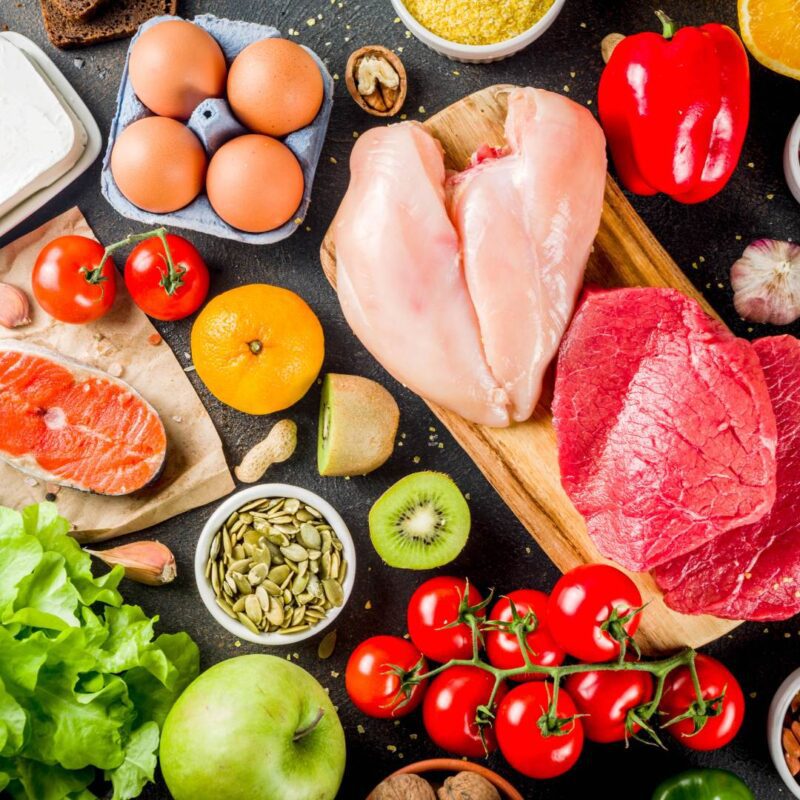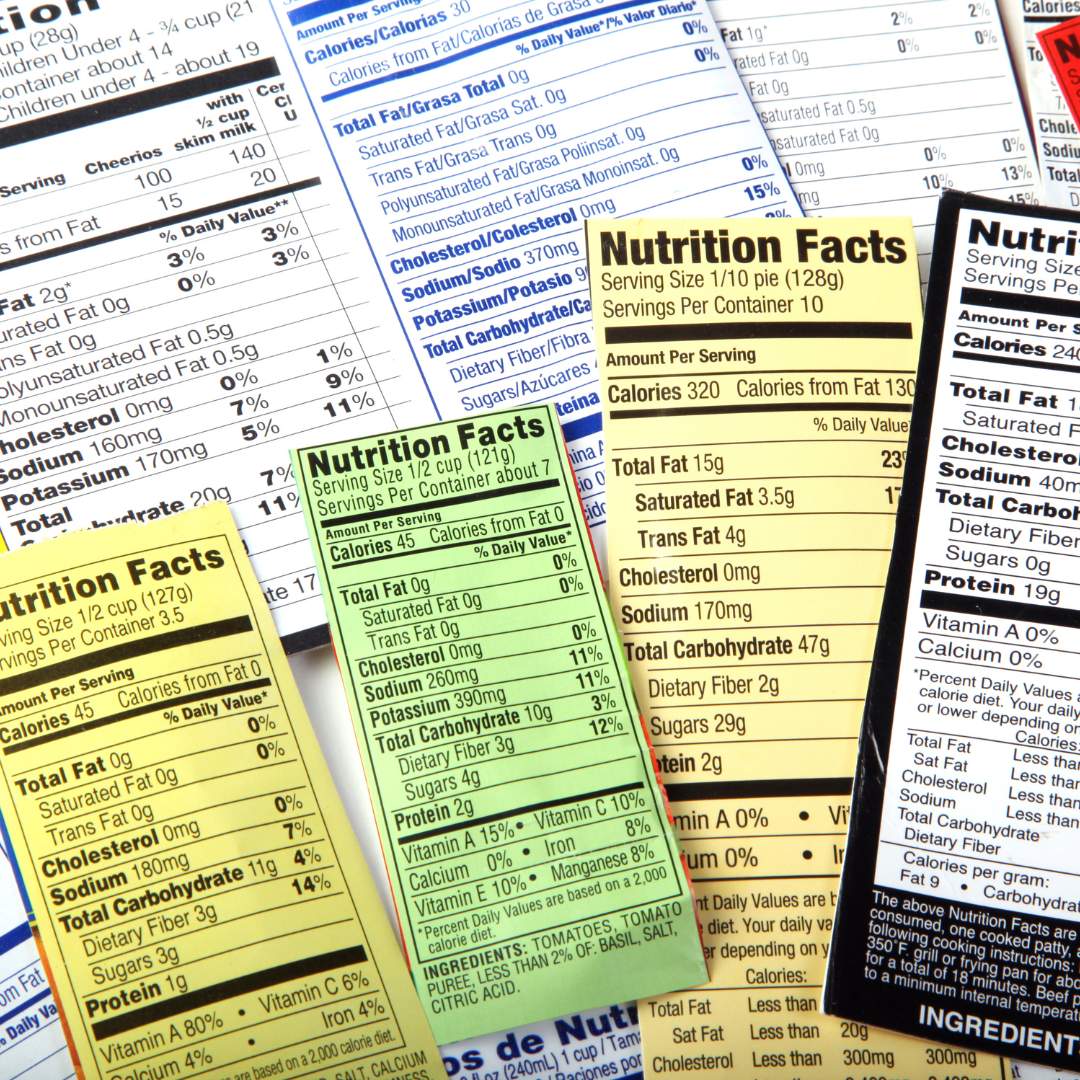
This post may contain affiliate links. Disclosure here.
Eating whole foods, which includes fresh produce, whole grains, and lean proteins, is the ideal meal choice. However, with today’s fast-paced grind, it can be difficult to purchase and cook all meals from scratch and we may need to turn to packaged foods. Some packaged foods are more nutritious than others, so it is important to read and understand the food labels for healthy eating.
Consumers are often tricked by marketing measures, and don’t really understand the hidden sugars, food colourings, and chemicals in their foods. Measures are often employed to make food products appear lower in calories, fat, and sugars when in fact that may not be the case.
So it’s important to understand the food labels for healthy eating and smart purchasing. This post will help clarify the information on the nutrition label so you can make informed decisions when food shopping.
Law in Canada
Nutrition labels on food packages and canned goods became law in Canada in 2007 to help consumers make informed decisions on their food purchases. By law, all labels must have the same information and format to allow for food comparison: portion size, calories, % Daily Value and 13 core nutrients and anti-nutrients, including fat, saturated fat, trans fat, cholesterol, sodium, carbohydrate, fibre, sugars, protein, Vitamin A, Vitamin C, Calcium, and Iron.
Portion Size & Calories
Portion size and calories are the first nutritional facts mentioned on a food label. It is important to take note of the portion size and compare that with what you would actually consume. Would you eat 3/4 cup of ice cream or 1/2 cup of chips if that is the label’s portion size?
Or would you actually double that amount? If so, ensure to double the calories and the rest of the nutritional levels. Manufacturers of ‘unhealthy’ food will often make their portion sizes small so that the calories, fat, and sugar count appear lower as well, hoping the consumer will not notice the difference.
The example below is a food label for Stove Top Stuffing. A 1/2 cup portion of the stuffing is 110 calories, which doesn’t sound too terrible; however, if you actually dish out 1/2 cup of the stuffing, you may realize that you are more likely to eat 2 cups of stuffing, making the calorie count 440 calories. That’s a big difference! Not only that, but the sugar content goes up to 8 grams in this example.
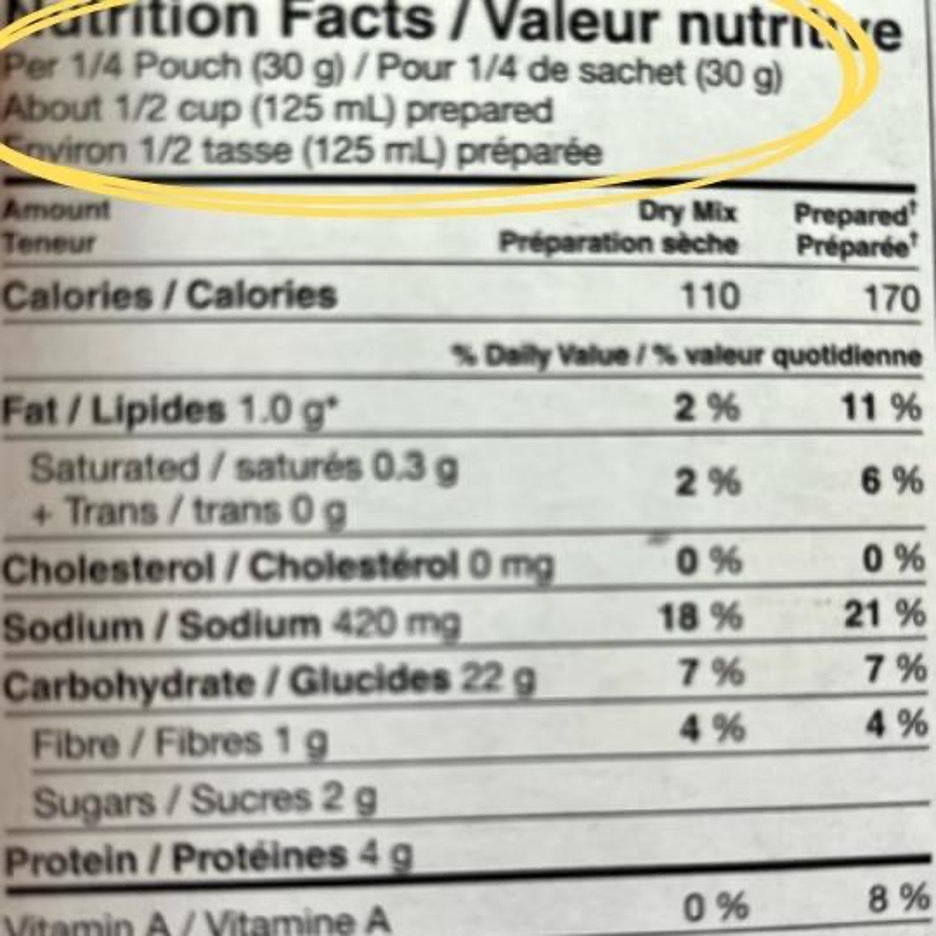
Percent Daily Value
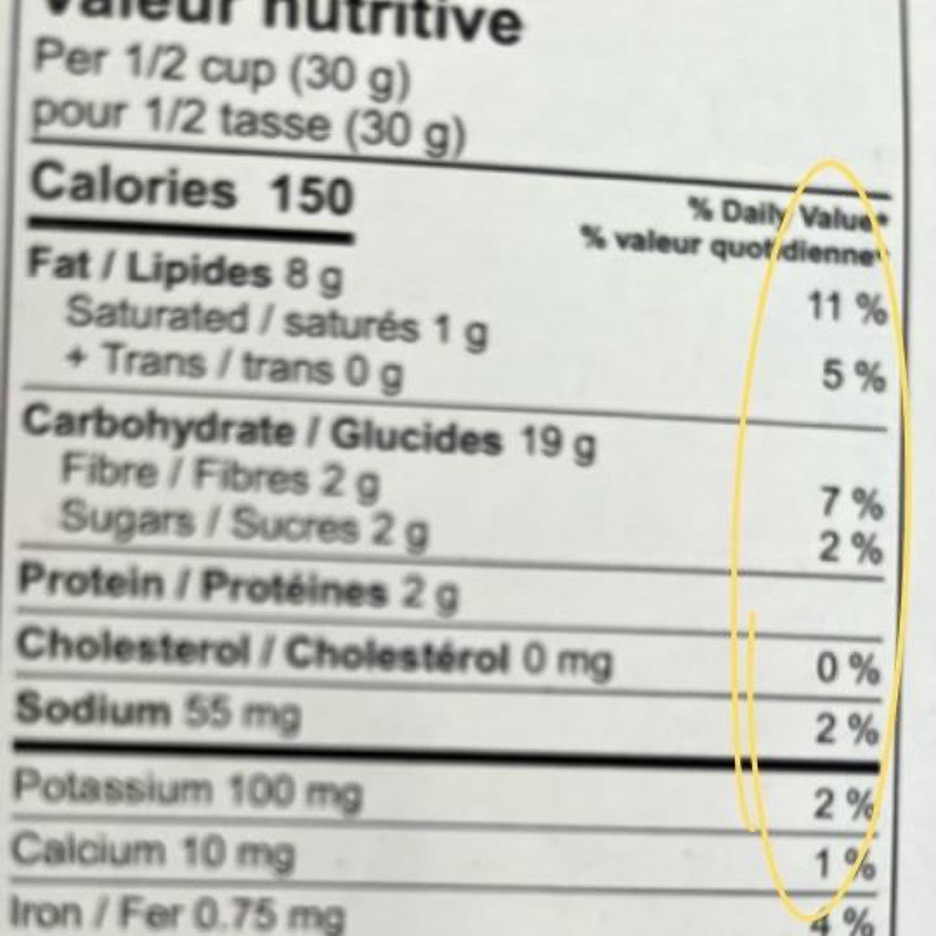
The Percent Daily Value (%DV) details how much a specific nutrient in a serving of food contributes to the total daily diet. The % DV helps consumers determine if a nutrient is high or low in a certain food product. A nutrient is considered low if it is 5% or lower and is high if 15% or more.
Aim to get higher %DV levels of dietary fibre, protein, Vitamin A, Vitamin C, Calcium, and Iron. And try to get lower amounts of fat, sodium, and sugar. Ensure you do not purchase a product with trans fat.
The %DV can help compare the nutritional content of various foods. However, if you are actively looking to increase a specific nutrient in your diet, make an appointment with your nutritionist to help with your food intake and meal planning.
Protein
Protein does not have a %DV specified on the label, so look at the amount of grams the product contains. It is always beneficial to purchase a product that has higher amounts of protein as protein is an important macronutrient that helps build bones, muscles, hormones, enzymes, and is involved in many important jobs in our body.
The exact amount of daily protein you need depends on many factors, including activity level, age, muscle mass, gender, and overall health.
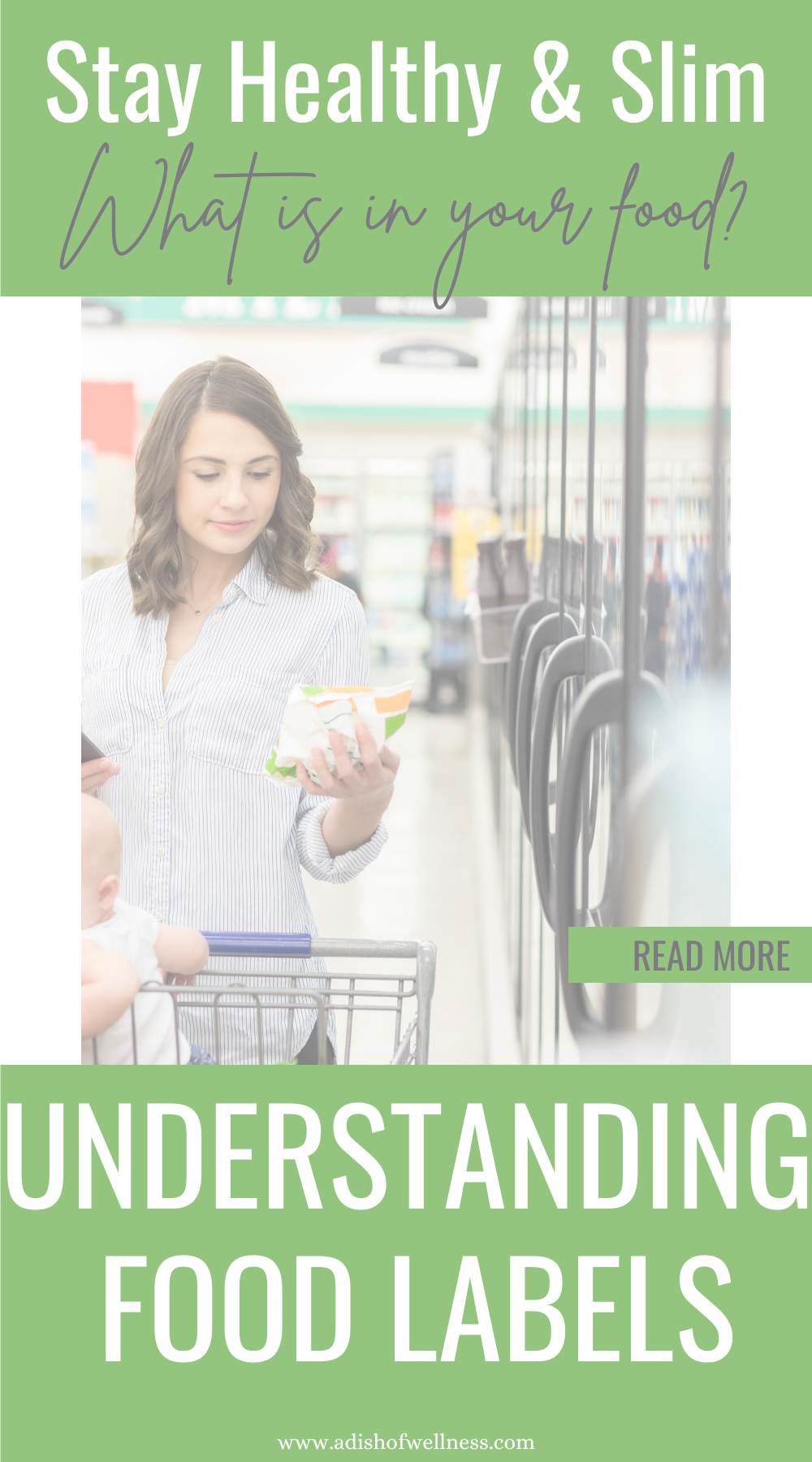
Ingredient List
The ingredient list is found on the bottom of the food label and lists product ingredients in descending order of weight and concentration. This means that the ingredient with the highest concentration in the product will be listed first. This part of the label is very important as it lets you know what is actually in your food.
You may be surprised to see that sugar is the first ingredient listed on your packaged food product, and you’d therefore know to bypass that product and find one with better ingredients. Often the ingredient list is very long with things you’ve never heard of before. Again, you’d want to bypass this product. The less ingredients listed, the better. One rule of thumb is to pick a product with ingredients you can pronounce.
Watch for Hidden Sugars

Sugar goes by a slew of different names, making it easy for manufacturers to hide how much sugar is in a given product. Even foods labeled as ‘natural’ or ‘healthy’ contain shockingly high amounts of added sweeteners.
The following long list includes names that sugar can be called on a food labels. This long list exlcudes artificial sweeteners and sugar substitutes:
Dextrose, Fructose, Galactose, Glucose, Lactose, Maltose, Sucrose, Beet sugar, Brown sugar, Cane juice crystals, Cane sugar, Castor sugar, Coconut sugar, Confectioner’s sugar, Corn syrup solids, Crystalline fructose, Date sugar, Demerara sugar, Dextrin, Diastatic malt, Ethyl maltol, Florida crystals, Golden sugar, Glucose syrup solids, Grape sugar, Icing sugar, Maltodextrin, Muscovado sugar, Panela sugar, Raw sugar, Sugar (granulated or table), Sucanat, Turbinado sugar, Yellow sugar, Agave Nectar/Syrup, Barley malt, Blackstrap molasses, Brown rice syrup, Buttered sugar/buttercream, Caramel, Carob syrup, Corn syrup, Evaporated cane juice, Fruit juice, Fruit juice concentrate, Golden syrup, High-Fructose Corn Syrup (HFCS), Invert sugar, Honey, Malt syrup, Maple syrup, Molasses, Rice syrup, Refiner’s syrup, Sorghum syrup, Treacle
Check your food label ingredient list, do you see more than one of these on the list?
Examples of Food Labels
The following two labels are both Greek Yogurt of the same brand. The first one is plain unsweetened and the second one is sweetened with fruit. The unsweetened yogurt is 100 calories for a 3/4 cup portion with 6 grams of sugar and 17 grams of protein. The sweetened yogurt is 200 calories for a 3/4 cup portion with 18 grams of sugar and only 13 grams of protein.
When looking at the ingredient list, Yogurt 1 only has 3 ingredients, while Yogurt 2 has many ingredients with sugar being one of the first ones mentioned. Yogurt 1 is clearly a healthier choice yet many people purchase yogurt with fruit without comparing labels. If you want fruit in your yogurt, it is best to buy plain unsweetened and then add your own fruit, berries, cinnamon and/or vanilla to flavour it.


Food Labeling Changes
The Government of Canada is currently making changes to the food labels, which should be in compliance by the end of 2022. These changes will improve the labels to make them easier for the consumer to understand. Because Vitamins A and C are easy for Canadians to get in our diet, it will be removed from the %DV. Instead Potassium will be added, because it is an important nutrient for healthy blood pressure, and apparently it is a nutrient many people lack in their diet.
The other thing to note is the ingredient list. Sugar ingredients will be grouped together in brackets, so the consumer will know all the forms of sugar in the product. Food colouring will also be labeled under a common name that can be recognized versus disguised in a long list of difficult to read ingredients.
Another important change is the changes to serving sizes. Serving size will reflect the amount people are more likely to eat, and if it is a single portion container, the serving size will be the whole container. For more information on the changes to the food labels in Canada, look to Food Labelling changes on the Canada.ca website.
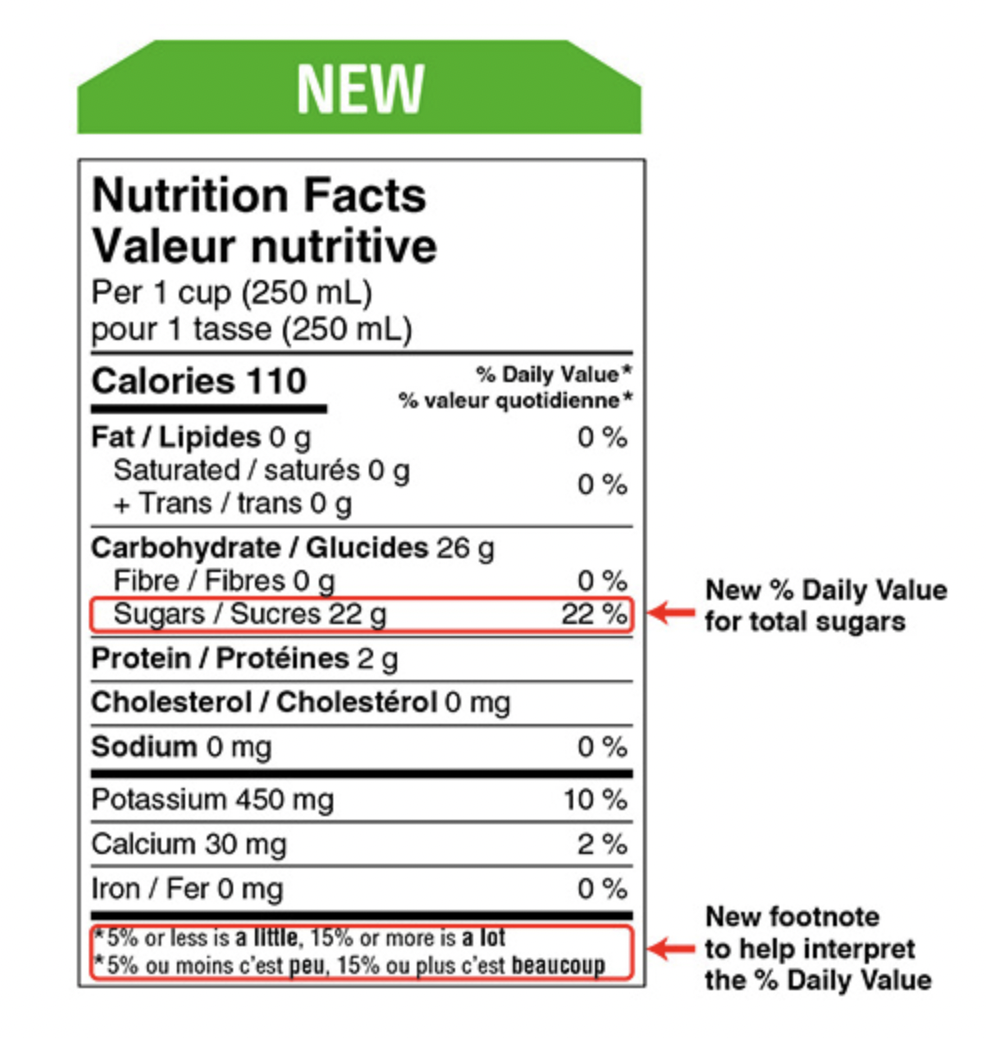
Conclusion
Eating real whole food is always your healthiest option, but it is not realistic that we would never consume packaged foods. So it is important to pick packaged foods that are the healthiest option. Look on the Nutritional Food labels to determine the calories, fat, sugar levels and the amount of protein fibre and carbohydrates in the product. Remember to choose foods low in sodium, sugar and fat, while looking for products high in protein, vitamins and minerals.
Frequently Asked Questions
1. What is the 5/20 rule?
As mentioned earlier in the section on %DV, the nutritional value is low if it is below 5% and high if it is higher than 15 or 20%. If you look at the above yogurt label, you will see that Calcium is 20%DV, which means the product is high in calcium, but it has 0% iron, making it low in iron content.
2. When it comes to reading food labels, what’s most important?
-Check the portion size and then consider the calories. Figure out the amount you would actually eat of the food product and then determine actual calories.
-Look to see how many grams of protein and carbohydrates are in the product.
-Look to see if fibre levels are sufficient. It is good to aim for 5 grams or higher.
-Look at ingredients. If there is a long list of unrecognizable foods, opt for another product. If the first ingredient is a sugar or another nonfood, opt for another product.
-Pick a product that is low in sodium and zero in trans fat.
3. How do you read food label ingredients?
Ingredients on a food label are usually listed at the bottom of the nutritional label. The ingredients are listed in descending order of weight and concentrations. This means that the ingredient with the highest concentration in the product will be listed first. So watch out for all those sugar terms listed above.



